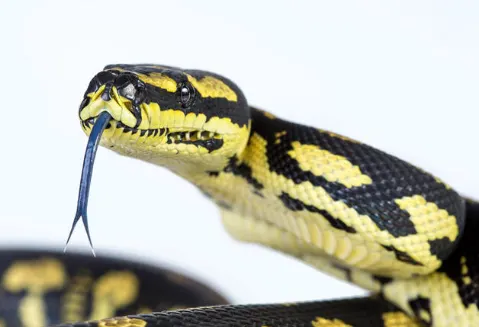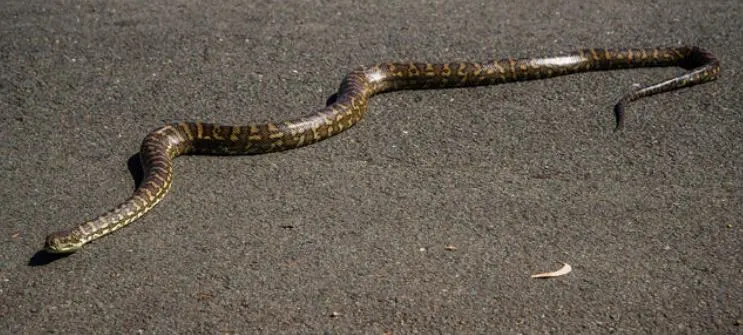The carpet python, known scientifically as Morelia spilota, is a popular and captivating species of snake. Native to Australia and Papua New Guinea, these snakes have a unique appearance, calm temperament, and impressive adaptability to various environments. Here’s a closer look at this remarkable reptile.

Table of Contents
What Is a Carpet Python?
The name “carpet python” comes from the snake’s striking scale patterns, which resemble the intricate designs of woven carpets. These snakes belong to the Pythonidae family and are known for their non-venomous nature. Carpet pythons are generally docile and can grow up to 12 feet long, making them one of the larger python species.
Where Do Carpet Pythons Live?
Carpet pythons are highly adaptable and can be found in a variety of habitats across Australia and Papua New Guinea. They thrive in rainforests, woodlands, grasslands, rocky cliffs, and even urban areas. These snakes are particularly skilled climbers, often spotted in trees, on fences, or even inside houses.
Types of Carpet Pythons
There are several types of carpet pythons, each with distinct patterns and colors:
- Jungle Carpet Python: Found in northeastern Queensland, this type has striking black bands on a bright yellow background. It typically grows to about eight feet in length and prefers rainforest habitats.
- Southern Carpet Python: Located in southern Western Australia and South Australia, this python has dark brown or olive scales with black splotches. It can reach a length of seven and a half feet.
- Diamond Python: This python is native to eastern New South Wales and New Guinea. It features black scales with yellow or white diamond-shaped patterns. It is known for its docile temperament and grows to an average length of seven feet.
- Darwin Carpet Python: Found in the northern section of Western Australia, this python has a mix of dark and light brown scales and grows to just under six feet.
What Do Carpet Pythons Eat?
Carpet pythons have a carnivorous diet, preying on a variety of animals, including:
- Birds
- Mammals like rabbits and mice
- Marsupials
They hunt using heat-sensing pits located on their heads, which allow them to detect warm-blooded prey. Once they find their target, they wrap around it to suffocate it before consuming it whole.
How Do Carpet Pythons Behave?
Carpet pythons are solitary creatures, except during mating season. They are most active during the warmer months of spring and summer, becoming less active in cooler autumn months. In areas with particularly cold winters, some carpet pythons may go into brumation, a state similar to hibernation.
Despite their large size, carpet pythons are known for their mild temperament. They rarely bite unless they feel threatened or startled. If they do bite, it’s important to clean the wound with hot water and soap and seek medical attention if the pain persists.
Are Carpet Pythons Dangerous?
While carpet pythons are not venomous, their bites can still be painful due to their sharp, backward-curving teeth. These teeth are designed to hold prey in place as the python swallows it. However, because of their generally gentle nature, carpet pythons are considered safe pets for experienced snake owners.
Carpet Pythons as Pets
Carpet pythons are popular pets among reptile enthusiasts due to their beautiful patterns, calm demeanor, and relatively low cost. They have a long lifespan, often exceeding 20 years with proper care.
However, carpet pythons are not recommended for beginners. Their size and sometimes unpredictable behavior can be challenging for someone new to snake ownership. Experienced snake owners are better equipped to handle these snakes and recognize signs of stress or discomfort.
For those who do keep carpet pythons as pets, it’s essential to provide the right environment. While they don’t need UV light because they are nocturnal, maintaining a consistent temperature in their enclosure with a reliable thermostat is crucial for their well-being.

Conservation Status
The carpet python is currently listed as “Least Concern” on the IUCN Red List, meaning they are not at immediate risk of extinction. However, habitat loss has led to a decline in their population in some areas. Conservation efforts focus on preserving their natural habitats to ensure their survival.
The carpet python is a remarkable species that has captured the attention of both reptile enthusiasts and casual observers alike. With their unique appearance, adaptable nature, and gentle temperament, they are a testament to the incredible diversity of the animal kingdom. Whether found in the wild or kept as a pet, carpet pythons continue to fascinate and inspire those who encounter them.
- Enchi Ball Python: A Unique and Stunning Morph of Python regius - March 27, 2025
- Emerald Tree Monitor: The Enigmatic Green Guardian of the Rainforest - March 26, 2025
- The Egyptian Cobra (Naja haje): A Fascinating Serpent - March 25, 2025
